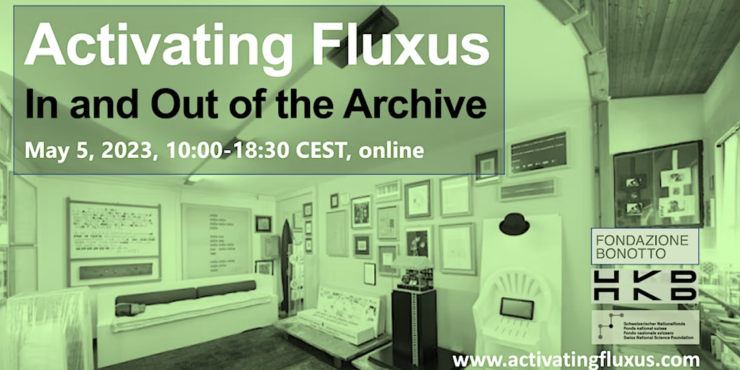
Location
Fondazione Bonotto & OnlineDate and time
-Fondazione Bonotto in collaboration with the research project Activating Fluxus (sponsored by the Swiss National Science Foundation and located at HKB | Bern University of the Arts, Switzerland) are pleased to announce the public event: "Activating Fluxus: In and Out of the Archive," taking place at the Fondazione Bonotto, Italy, and available to audiences online. This event brings together eminent speakers to engage with the notion of the archive and consider the archival space as a potential site for activating works created since the 1960s, with a particular focus on Fluxus.
Speakers include:
Elke Allgaier, Staatsgalerie Stuttgart, Archiv Sohm
Lionel Bovier, MAMCO and Ecart Archives, Genève
Elke Gruhn, Nassauischer Kunstverein Wiesbaden
Hanna B. Hölling, Aga Wielocha, Josephine Ellis, SNSF Activating Fluxus, HKB Berne
Laura Montanari and Alessandro Gazzoti, Pari&Dispari Archivio, Reggio Emilia
Patrizio Peterlini, Fondazione Bonotto, Colceresa
Hubertus von Amelunxen, Archivio Conz, Berlin
_____________
Activating Fluxus: In and Out of the Archive
The activities of Fluxus (from the Latin word meaning ‘flow’) fluctuated across a dense international network of artists in the 1960s-70s. Indicating a state of mind rather than an art movement, Fluxus is inherently difficult to define - in this vein, the creative outputs of Fluxus reject any stable, material form. As something transitory, ephemeral or imagined, at times based on foodstuffs, organic debris, actions or three-dimensional notation, Fluxus artworks continue to complicate the concept of a timeless art that is supposedly created to last forever. The identities of Fluxus artworks thus cannot be attributed to any one physical manifestation but materialize processually through an open totality of indeterminate forms and relations.
Caring for the legacy of Fluxus, therefore, not only requires accepting change as integral to the ongoing life of Fluxus artworks but also as a positive value: an invitation to creatively engage with the porosity of a given work’s boundaries. As a result, while historical iterations of Fluxus works from the 1960s-70s can be safeguarded as important documents of the recent past, our project aims to explore different modalities for engaging with the Fluxus spirit, beyond questions of physical preservation and towards the more imaginative horizon of activation.
Activation, loosely conceived, suggests creative engagement with Fluxus works using methods such as reconstruction, adaptation and artistic reinterpretation of Fluxus forms. Through this proposition to activate - not just preserve - Fluxus, the notion of the archive sheds its traditional function as a historical repository that contextualizes works of art. Instead, the archive is foregrounded as integral to present constructions of Fluxus works, comprising and comprised of artistic materials that can transform what the meaning of a work is and might potentially be.
This panel brings together eminent figures in the fields of archiving and collecting Fluxus materials to critically discuss activation as a mode of continuing and caring for the Fluxus legacy. Dick Higgins’ Intermedia Chart (1995) will be the starting point for our discussion. Drawn up during a conversation with Luigi Bonotto on January 19, 1995, Higgins’ chart is a graphic depiction of his ‘intermedia’ concept that describes artworks that fall in-between artistic media and trouble the boundaries between art and life. For almost three decades, the Fondazionne Bonotto has invited artists - including Julien Blaine, Philip Corner and Mieoko Shiomi - to adapt Higgins’ original chart according to their own understandings of intermedia. These creative interventions serve as an apt example of activation, in which change offers a rich modality for continuity and also allows for conceptual evolution.
The following questions will be raised: What role does the archive play in the activation of Fluxus historical works? How might the archive be used to effect change, and not only stabilize, such works? What relations, amongst archivists, curators and conservators, are required to sustain the life of Fluxus? Who decides what constitutes the legacy of Fluxus works? Who is this legacy for? And fundamentally, what does it mean to activate Fluxus?
Our exploration of the potentials and challenges for activating Fluxus will contribute to the design of an “Activation Toolkit” for Fluxus archives and collections. This toolkit will aim to inspire current and future stewards of Fluxus art to creatively engage with what it means to continue the Fluxus legacy. At the same time, the notion of activation offers an opportunity to expand established approaches for conserving changeable artworks that have emerged since the 1960s.
_________________
Activating Fluxus is a research project that started in April 2022 at the Institute of Materiality in Art and Culture, Bern University of the Arts (HKB). Funded by the Swiss National Science Foundation, the project consists of an interdisciplinary team of researchers, including Prof. Dr. Hanna B Hölling (project lead), Dr. Aga Wielocha (postdoctoral fellow), Josephine Ellis (doctoral candidate), Marcus Gossolt (artistic collaborator), and a network of associated researchers: Johannes M. Hedinger, Sally Kawamura, Elke Gruhn, Stefanie Mathey and Émilie Parendau. Together they are investigating the transitory international lives and afterlives of Fluxus objects, events, and ephemera created from the 1960s - 1970s, not destined for preservation.
FONDAZIONE BONOTTO was established in order to promote the Luigi Bonotto Collection which has collected, since the early 1970s to the present, numerous testimonies: works, audio documents, videos, posters, books, magazines and editions of Fluxus artists and International verbal-visual research developed from the late Fifties. FONDAZIONE BONOTTO aims to promote and develop a new way of relating between art, business and contemporary culture at an international level. These are the three main pillars around which the life, activity and success of Luigi Bonotto, the Fondazione's creator and sponsor, have developed.
________________
This event is free, but you will need to register in order to attend. A Zoom link will be sent to registrants a day before the event. Register here: https://www.eventbrite.com/e/activating-fluxus-in-and-out-of-the-archiv…